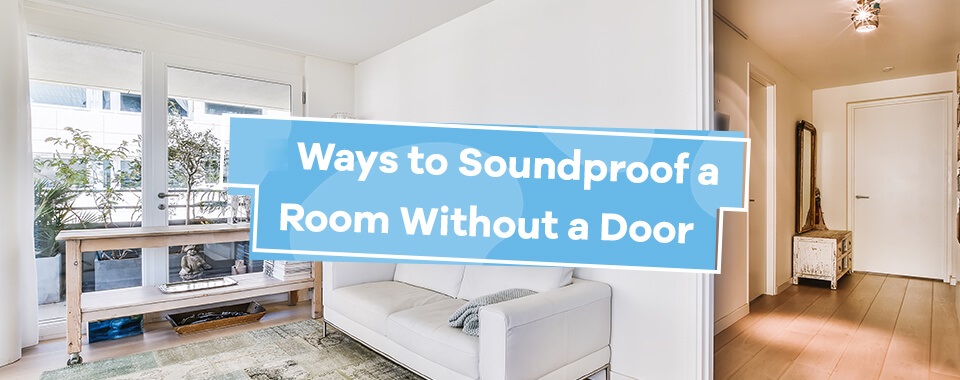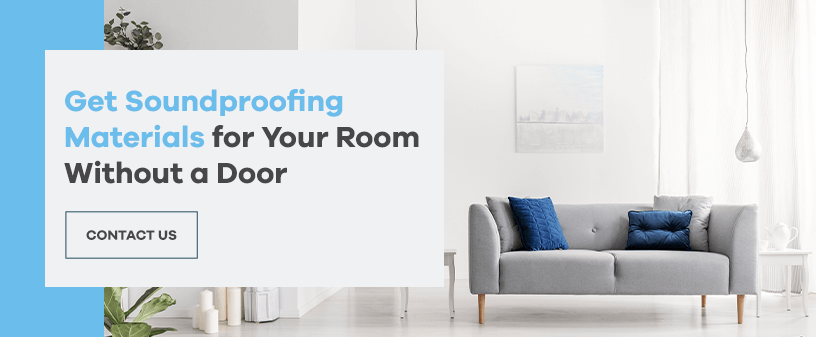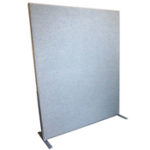
Every room has an entryway, but not every room has a door. If your home is under construction or you have an unimpeded opening between rooms, you may forgo the door temporarily or permanently. An open doorway can allow sound to travel out of the room, but there are ways to soundproof a room with no door.
You can soundproof an empty doorway with materials you have at home or by purchasing professional soundproofing materials from Soundproof Cow.
How to Soundproof a Room With No Door or an Open Doorway
These six solutions can effectively reduce sound in your doorless room.
1. Use Acoustic Room Dividers
Acoustic room dividers provide an effective sound-blocking solution. These differ from room dividers that simply break up the flow of the room. They dampen sound, and you can put one in the door frame to cover as much room as possible. Fill in any gaps between the divider and the doorway with soft material, such as:
- Rugs or heavy curtains.
- Cushions.
Acoustic room dividers reduce echoing in the room, although they do not block noise from outside the room.
2. Hang Thick Curtains
You can use thick drapery to block an empty doorway. While curtains are not as effective as installing and soundproofing a door, the thickest curtains have enough mass to block some noise. Those with dense, fibrous fabric also have absorption qualities, helping reduce sound reflections inside the room.
You can hang the curtains in the door frame by installing a curtain rod above it. The curtains you choose should reach to the floor and cover the opening’s width. You can strengthen the seal by taping or tying the ends to the wall and floor. Using two or more layers of curtains will improve the results. This solution is a practical blend of temporary and permanent measures — you can leave the curtains up at all times, push them aside when you leave the room and pull them shut when you reenter.
3. Hang an Acoustic Quilt
An acoustic curtain is a step up from soundproofing doorways with a curtain. These products feature distinct design qualities that help them block and absorb sound. A great example is the Quiet Barrier® Acoustic Quilt. This product features a nonporous vinyl exterior lining that can block and reflect sound. The inside features a 1-inch-thick sheet of an absorbent fiberglass-based material. Durable metal grommets around the perimeter make it easy to hang these curtains on hooks, nails, wire or string.
4. Push Furniture in Front of the Door
Putting a physical barrier between your room and the rest of the house can also soundproof a room, though it can impede your access to the room and your decorating options. You can use this temporarily until you find a more permanent solution.
The more you put in front of the doorway, the better the soundproofing will turn out. Fill in the rest of the area with cushions and other soft things that absorb sound.
5. Build a DIY Noise Barrier
You can create a temporary barrier that replicates the effects of a solid or thoroughly treated hollow-core door. This solution requires a few materials that are readily available at hardware stores and through Soundproof Cow.
- Purchase a ½-inch extruded polystyrene panel large enough to cover the opening. You can fasten multiple panels together if the opening is larger than the sheets available.
- Purchase Quiet Barrier® HD mass-loaded vinyl (MLV) through Soundproof Cow.
- Remove the MLV’s label to reveal the adhesive side, then apply the sheet to the polystyrene panel. Use multiple sheets to cover the entire panel. Creating multiple layers can increase the effect.
- Use a utility knife to trim excess MLV or polystyrene from the ends.
- Apply a strip of hook and loop tape to the surfaces above and beside the opening.
- Apply hook and loop tape to the barrier’s perimeter level with the strips on the wall.
- Fasten the barrier in front of the doorway using the hook and loop tape. Remove the barrier as needed.
- Create a second barrier for the opposite side of the entryway to replicate a decoupled wall.
6. Seal Small Openings
While the open entryway is the most significant challenge, filling smaller cracks and gaps will still help. Air pockets around the room’s skirting and trim allow sound to escape regardless of the treatments you apply to the opening. You can fill cracks using acoustical sound sealant, which is a type of caulk specialized for soundproofing applications.
Get Soundproofing Materials for Your Room Without a Door
Soundproofing a doorway is possible with professional-grade materials like MLV, acoustic curtains and acoustic partitions. Soundproof Cow has products that can transform a room’s acoustics and reduce transmission to others nearby. We have everything you need for a high-quality sound-blocking experience. Reach out to us online for more information.













